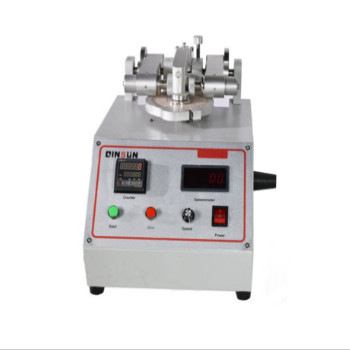Taber Abrasion Tester test result evaluation

Taber Abrasion Tester is used to evaluate the abrasion performance of various materials such as textiles, cloth, paper, paint, plywood, leather, floor tiles, glass, natural rubber and plastic sheets.
Experimental principle:
Apply a specified load and speed to the test sample placed on the test bench. When the test bench rotates, it drives the abrasive wheel to wear the sample. The weight lost by abrasion is the difference in weight between the samples before and after the test. The wear resistance is estimated according to the standard method.

Advantages:
1. The company has been engaged in testing instruments for more than ten years and has a strong after-sales service team;
2. Be able to deal with various problems in a timely and fast manner, and relieve customers from worries;
3. Spare parts are available to solve the trouble of long lead time for ordering spare parts;
4. Provide outsourced maintenance services;
5. Long-term supply of various commonly used testing instruments;
6. Keep up with the update of industry standards and provide testing instruments that meet the new standards in a timely manner.
Evaluation of experimental results:
The evaluation of wear resistance can be compared with the standard sample of the same nature under the same test conditions. It is suggested to observe from the following aspects.
1. Appearance and performance:
Changes in gloss: changes in surface properties (pilling, fuzzing);
Color change: first time fiber breakage seen, first hole found.
2. Physical properties:
changes in thickness;
Changes in breathability;
changes in weight;
Changes in force (stretching or crushing).
3. Weightlessness method:
The weight loss per unit area is the difference between the original weight of the sample and the weight after wear, and the percentage of the worn area of the sample, that is:
Weight loss per unit area = W0-W1/S
In the formula:
W0---the original weight of the sample (g);
W1---the weight of the sample after wear (g);
S---sample wear area (cm2)--this instrument is 20cm2;
If the calculated data is too small, it can be converted into g/m2.
4. Loss of strength method:
The strength difference (%) is the difference between the original strength of the sample and the strength after wear, and the percentage of the original strength, that is:
Intensity difference (%)=A0-A/A0;
In the formula: A0---the original strength of the sample (N);
A---The strength of the sample after wear (N)
The Taber Abrasion Tester - 5135 experimental equipment independently developed and produced by QINSUN Instruments is cost-effective and complete after-sales. Welcome customers in need to inquire.
2022-12-21 11:31

